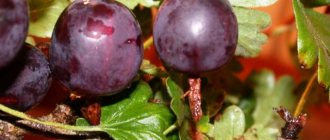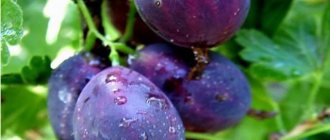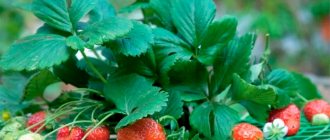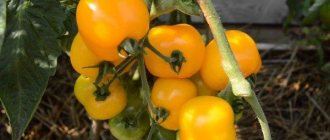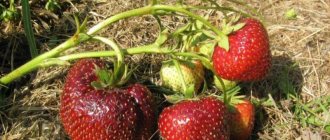General information about the English Yellow variety
Shrub 1.5 meters high, slightly spreading. The English gooseberry variety has a high degree of resistance to low temperatures. The origin of this variety is unknown, but breeders note the yield and taste of the fruit.
The berries have the following description: medium density, yellow flesh, do not crumble after ripening. The average weight of the berry is 5 grams, however, with high yields, the weight of the gooseberry can be up to 7 grams.
Gooseberry shoots are covered with single thorns, the leaves are small and dark green in color. The inflorescences are white, with brown sepals.
Characteristics and description of bushes
The Baltic gooseberry has a spherical crown no more than 110 cm high. The shoots are erect, with a large number of large thorns. The leaves do not differ in appearance and color from other varieties of the crop. They are heart-shaped, oval-shaped, with 3-5 lobes, dark green in color, wrinkled and leathery. The top of the leaf blade is covered with a waxy coating. The leaves and petioles are completely devoid of pubescence.
Baltic gooseberry is a mid-season variety.
Temperature resistance
In the regions of central Russia, the variety shows high frost resistance - it is not afraid of temperature drops to -30°C. In frosts down to -35…-38°C, plants’ growth for the current year freezes. Therefore, in the gardens of Siberia and the Urals, gooseberries are grown with light shelter for the winter.
Moisture and drought resistance
The plant has average drought tolerance. In the absence of soil moisture for a long time, the gooseberry sheds some of its foliage. If drought occurs during the period of formation and filling of fruits, this will affect their presentation and taste. The berries will be small, without a pronounced taste and aroma.
Resistance to diseases and pests
The variety is highly resistant to powdery mildew and anthracnose. These diseases are common in central Russia in years with unfavorable, rainy summers.
Pros and cons of gooseberries
The culture has advantages and disadvantages that need to be taken into account when growing.
| pros | Minuses |
| Good tasting berries | When the humidity is high, the berries crack |
| Berry size | The culture is not resistant to the sphere library |
| They do not fall off after ripening, which makes the harvesting process simple | |
| Retain their presentation for a long time | |
| High yield | |
| The shrubs are slightly spreading, which makes caring for the crop comfortable | |
| The spikes are medium in size | |
| The culture is resistant to diseases and low temperatures | |
| The plant is undemanding to the type of soil |
A crop with good taste, which makes it popular among gardeners. Gooseberries have an attractive appearance and are used for winter preparations.
Basic landing rules
To obtain a harvest, gooseberries require compliance with certain planting methods, which will not only reduce the risk of disease, but also improve taste.
Dates and place of landing
Gooseberries are a type of crop that can be planted in autumn and spring. In spring, the bush is planted in the soil after the snow has melted and before the buds begin to open. In autumn, the shrub is replanted from mid-September to mid-October. In the period before frost, the crop takes root and the plant is less susceptible to disease.
English gooseberries are undemanding to soil, but for normal development of the crop it is necessary to choose soil with neutral acidity. The planting site should be sunny and not shaded by nearby trees. It is not recommended to use places for planting in which soil moisture is increased, in which case the plant is susceptible to diseases such as rot.
Site preparation
The planting site for English gooseberries is prepared 4-5 weeks in advance so that the soil has time to settle. The area where gooseberries will be planted must be cleared of grass and roots of other plants. If a crop is planted in a garden, a distance of at least 2 meters must be maintained between the planting site and other crops.
Before digging the soil, you need to prepare the mixture:
- humus - 10 kg;
- wood ash - 150 grams;
- superphosphate - 2 tablespoons;
- potassium - 2 tablespoons.
See also
Description of the best varieties of thornless gooseberries for different regionsRead
A depression is made, the soil from the hole is mixed with the previously prepared composition and placed in the prepared hole. This will saturate the area with the substances necessary for root development.
Important. Gooseberries should not be planted after plants such as raspberries and strawberries. In this type of soil, the plant will not be able to take root and develop to obtain the required yield.
Selection of seedlings
When choosing a seedling for planting gooseberries, you need to pay attention to the following features:
- The root should consist of 4-5 shoots at least 10 cm long.
- The shoot must have no external damage. The presence of several shoots is allowed; this occurs if the seedling is over 2 years old.
- The length of the shoots should be 20-30 cm.
To reduce the time it takes for a plant to adapt to a new location, it is recommended to give preference to seedlings that have root protection in the form of a clod of earth. However, bare roots can be used if there is no visible damage.
Step by step process
Gooseberries must be planted according to the following algorithm:
- a hill is formed in a previously prepared place;
- the seedling is placed on a hill and all the roots are straightened;
- the seedling is sprinkled with soil on top;
- the neck of the gooseberry should be immersed to a depth of at least 10 cm;
- the soil is compacted and watered with a bucket of warm water;
- the planted plant must be pruned; if this procedure has not been performed previously, only the 5 lower buds are left.
When planting gooseberries in large quantities, it is necessary to maintain a distance of at least 1 meter between the bushes.
Rules for caring for English gooseberries
An adult bush, like a seedling, requires a certain type of care. Timely application of fertilizers and watering of the crop will contribute to the development of shrubs and the annual harvest.
Watering and fertilizing
The gooseberry variety tolerates moderate drought, the English yellow variety is susceptible to root diseases in the presence of excessive moisture. Watering the crop is carried out in several stages, among which it is necessary to highlight:
- the first is carried out on the 20th of May;
- the second watering is carried out a month later;
- the third is after the harvest.
In dry weather, the shrub needs to be watered every three weeks. Watering is carried out in the following way:
- measure a distance of 60-70 cm from the root of the bush;
- make a ditch 10 cm deep around the bush;
- water is poured into the ditch.
Up to 30 liters of water must be used per adult plant.
Fertilizers are applied to the soil according to the following scheme.
| Feeding period | Fertilizer type |
| First days of April | Boil 1 kg of potato peelings in 10 liters of water. Leave to room temperature, add 200 grams of ash. Mix everything thoroughly and pour into the root area of the bush. |
| After the color falls | Mix 200 grams of urea, 400 grams of superphosphate and 100 grams of potassium in 5 liters of water. A bucket of clean water is poured into the ditch, with the resulting solution on top |
| During fruit formation | Bird droppings are used in the proportion of 1 kg per 10 liters of water |
| After harvest | 2 buckets of humus are brought under the bush and watered generously |
It is recommended to apply fertilizer in the evening after sunset.
Trimming
In the second year after planting, it is necessary to leave 2-3 strong shoots. Every year it is necessary to form a bush, while old branches are removed and young shoots are left in place.
See also
The best way to feed gooseberries, how to water them properly in summer and autumnRead
Pruning is carried out in spring and autumn; all damaged and small shoots must be eliminated. Branches that are intertwined in a large number of places are also removed. In order for the bush not to outgrow fruiting, it is necessary to shorten the shoots by one third annually.
Sheltering shrubs for the winter
After the leaves fall, it is necessary to prepare the shrub for the winter:
- clear the soil around the crop from leaves, dig it up and add humus;
- collect the branches of the bush and tie them with a strip of fabric;
- treat the branches with a solution of Bordeaux mixture (1%);
- Wrap the branches with burlap.
Digging the soil is necessary to eliminate pests that may be hiding in fallen leaves and branches.
Gooseberry variety “Kuršu Dzintars”
This is another mid-season variety of gooseberry, which looks organically in the landscape design of the garden, vegetable garden and personal plot as a whole. Its foliage has a beautiful light green color and fills everything around with its visual freshness. It is noteworthy that the base of the leaves has a clearly visible yellowness: by this “imprint” one can distinguish the variety “Kuršu Dzintars” from any other similar one. The fruits of this variety of berry are small. They have an oval shape. They are painted yellow and have an interesting characteristic shine - as if they were covered with a glossy substance on top.
Harmful insects and their control
English gooseberries can be affected by the following types of insects:
- Gooseberry aphid - the pest forms seals on burgundy-colored leaves. The pest feeds on the sap of leaves and causes them to turn yellow. To eliminate aphids, the substance “Sumicidin” is used.
- Spider mite - appears as light-colored spots on the leaves. Can lead to a decrease in yield and death of the crop. It is necessary to treat the plant for mites before the buds open. The substance used is Wofatox.
- The moth is an insect that penetrates the berries and causes them to rot. To eliminate the pest, it is necessary to use “Karbofos”, which is sprayed onto the bush before the inflorescences appear.
Treatment against possible pests must be carried out after the snow melts in April.
Gooseberry variety “Spring”
Small and rather large - the bush of the “Spring” variety looks quite neat and very compact. The berries of this gooseberry are round in shape and only barely elongated along their axis. The average weight of each berry is six grams. But under favorable conditions, larger specimens weighing eight grams each ripen on the bush. The fruits of this gooseberry variety are yellow-green. Yes, it is not entirely sunny and uniform. But since the berries are more yellow than salad, we decided to include “Spring” in our list. The taste of the berries is sweet and delicate. They are used not only fresh, but also after heat treatment. For example, for making preserves and jams, as well as a variety of confitures.
The advantage of the “Rodnik” variety is the culture’s resistance to fungal diseases. In addition, this variety tolerates sudden temperature changes well, and therefore is ideally suited for cultivation in Ukraine.
Protection against gooseberry diseases
Gooseberries are resistant to diseases, but the following types of diseases may appear:
- Powdery mildew - appears as a gray coating on the leaves. The disease causes leaves to curl and turn yellow. To prevent the disease, it is necessary to treat it with a solution of vitriol before the buds open.
- Anthracnose - affects the shoots, leading to cracking of the bark, causing the plant to dry out. This disease is of the fungal type and can affect the plant, starting from the root system. To combat the disease, spraying with Cuprozan is used before the buds of the crop begin to open.
- Rust - manifested by the appearance of brown spots on leaves and shoots. To prevent the disease, the drug “Nitrophen” is used.
Affected shoots must be removed from the bush, otherwise the disease will progress.
Gooseberry variety “Amber”
This variety of berry variety received its name precisely because of the color of the fruit. They are painted in a natural amber shade: it seems that nature mixed together sunny, orange and honey shades - and as a result received the color of one of the most sought-after precious minerals. However, why do we give all the laurels to nature? In fact, the “Amber” variety is the merit of the breeders. The bush is medium-sized and grows up to one and a half meters in height. Ripens very early, is not afraid of diseases. As well as frosts. The variety bears fruit quite abundantly and, to tell the truth, is distinguished by high yield. Picking berries is quite comfortable: although thorns are present on the stems, they are only here and there.
Harvest and storage
Ripe berries are yellow with a honey tint. The fruit tastes sweet and aromatic. English gooseberries ripen at the end of July.
After harvesting, the berries are placed in a box in a thin layer and placed in a cool place. Gooseberries can be stored for up to 5 days. In order to increase shelf life, it is recommended to pick 2-3 days before full ripening, however, such berries have a less intense taste.
English gooseberries are famous for their taste, which is unlike other varieties. The crop also has high yields and attractive berries. The shrub adapts to a new growth location and does not require excessive watering.
Features of reproduction
Yellow English gooseberries can be propagated in several ways: cuttings, layering, and dividing the bush.
Gooseberry bushes older than 3 years are propagated by horizontal layering. More than 5 young seedlings can be obtained from one mother plant. They will not lose the varietal qualities of the mother plant.
Cuttings are also effective for propagating yellow English gooseberries. To obtain productive cuttings, mature shoots covered with woody bark are cut off. Then they are divided into several parts and germinated. With this method of propagation, you can obtain an unlimited number of young seedlings.
You can divide the bush in autumn or early spring into 2-3 parts. The separated plants are rooted and their survival rate is quite high.
Each of these methods is effective and allows you to preserve the varietal characteristics of the mother plant.
Important! By propagating yellow English gooseberries from cuttings, you can get the maximum number of new seedlings.

